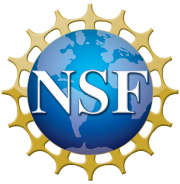Vis-a-thon 2025
Moon Beads: Reimagining the Apollo Archive
Authors
Tom Williams PhD Candidate, Brown University, Department of Earth, Environmental and Planetary Sciences twilliams.info
COLLABORATOR
Lauren Russo MLA, Rhode Island School of Design, Landscape Architecture
Critic
Leah Beeferman
Our project merges planetary geochemistry, imaging, and critical theory to engage with lunar samples from NASA’s Apollo 17 mission, preserved records of volcanic activity over three billion years old.
Moon Beads: Reimagining the Apollo Archive, a stereoscopic anaglyph inkjet print, reinterprets the iconic Apollo Earthrise photograph taken by astronaut William Anders on December 24, 1968, during the Apollo 8 mission. The image includes a creative insertion of an SEM image of a lunar bead (in place of the original moon), on which we embedded a nano-typographic message, Hello World, using focused ion beam induced platinum deposition. Just as the phrase marks the first programmatic step in text-based code (the language of the SEM interface), in this context it implies a first step in reimagining our relationship with more-than-human beings and scientific processes. This tiny greeting, then millionths of a meter across, challenges the traditional boundaries between scientist, machine, and specimen and raises ethical questions about human intervention in scientific artifacts.
INITIAL PROPOSAL NOTECARD
"When first trying to define the project, I knew that I wanted to go beyond the 2D nature of a computer screen, but I never expected us to blend reality of different scales into a 3D anaglyph. In doing so, the push to create – rather than just observe – forced us to find new ways of using the equipment, some of which neither of us were sure would work."
—Tom
"This tiny inscription, the canonical start of any code, becomes a speculative act: a first “hello” to both machine collaborators and more-than-human entities. It asks what it means to “speak” to the Moon, to interact with scientific specimens not just as data, but as relational beings."
—Lauren
"I often found myself doubting that something was possible, but Lauren’s creativity, and our shared need to go beyond purely “scientific” constraints, allowed us to gain insights from my samples that could never have occurred without the demands of the VIS-A-THON."
—Tom
At its center is a stereoscopic anaglyph inkjet print that reimagines the iconic Earthrise photograph taken by astronaut William Anders (Apollo 8, 1968). We replaced the Moon in the image with a scanning electron microscope (SEM) image of a lunar glass bead, embedding within it the nano-typographic phrase: “Hello World”—written using the SEM’s platinum deposition tool at a scale one-billionth the width of a human hair.
Tools Used in the Project
ION beam Scanning Electron Microscope Earthrise archival image Lunar bead sediments Inkjet printer
Copyright
© Moon Beads, 2025

This material is based upon work supported in part by the National Science Foundation under EPSCoR Cooperative Agreement #OIA-1655221.
Any opinions, findings, and conclusions or recommendations expressed in this material are those of the author(s) and do not necessarily reflect the views of the National Science Foundation.





